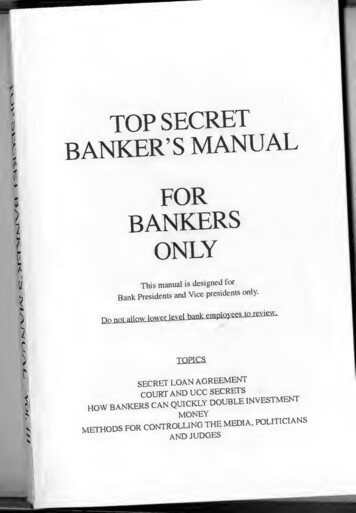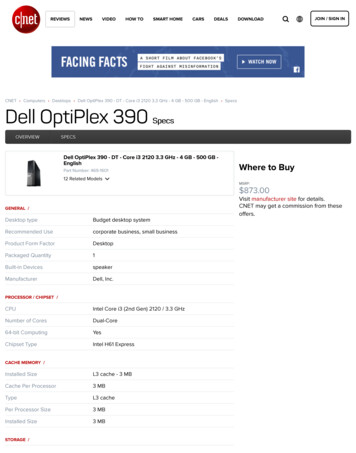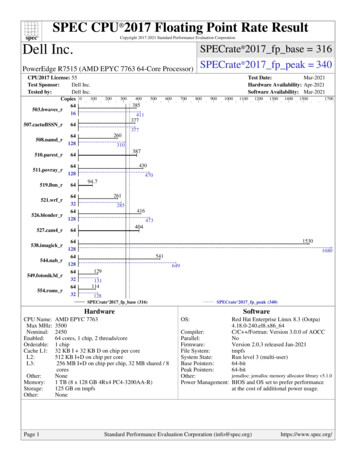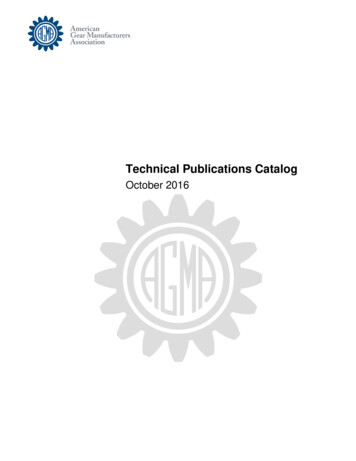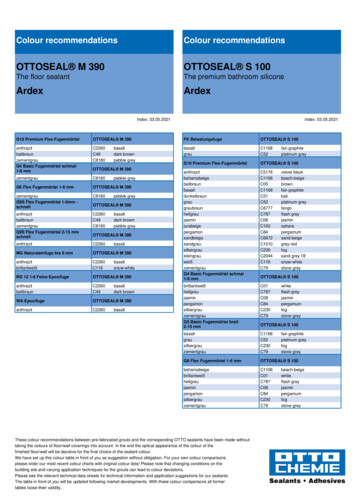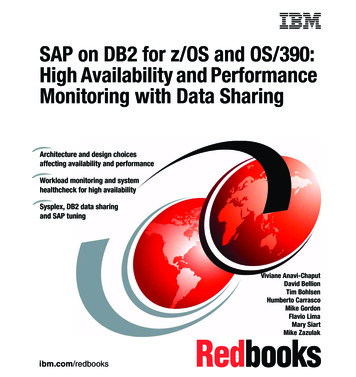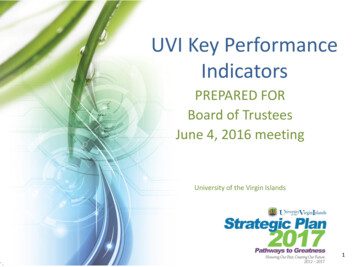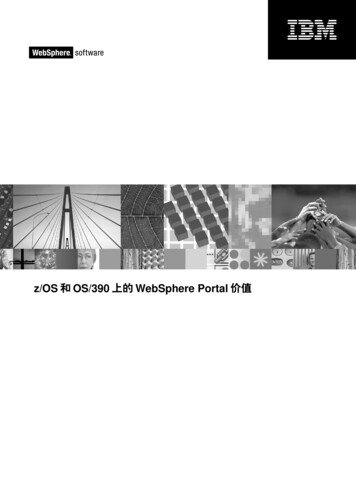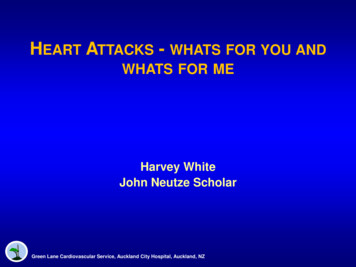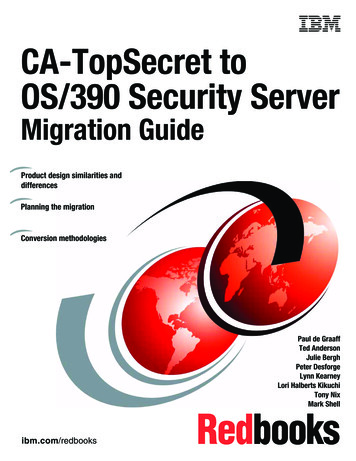
Transcription
CA-TopSecret toOS/390 Security ServerMigration GuideProduct design similarities anddifferencesPlanning the migrationConversion methodologiesPaul de GraaffTed AndersonJulie BerghPeter DesforgeLynn KearneyLori Halberts KikuchiTony NixMark Shellibm.com/redbooks
International Technical Support OrganizationCA-Top Secret to OS/390 Security ServerMigration GuideOctober 2000SG24-5677-00
Take Note!Before using this information and the product it supports, be sure to read the general information in Appendix D,“Special notices” on page 109.First Edition (October 2000)This edition applies to SecureWay Security Server Version 2, Release Number 10, Program Number 5645-001 foruse with the OS/390 Operating SystemComments may be addressed to:IBM Corporation, International Technical Support OrganizationDept. HYJ Mail Station P0992455 South RoadPoughkeepsie, NY 12601-5400When you send information to IBM, you grant IBM a non-exclusive right to use or distribute the information in anyway it believes appropriate without incurring any obligation to you. Copyright International Business Machines Corporation 2000. All rights reserved.Note to U.S Government Users - Documentation related to restricted rights - Use, duplication or disclosure is subject to restrictionsset forth in GSA ADP Schedule Contract with IBM Corp.
ContentsFigures . . . . . . . . . . . . . . . . . . . . . . . . . . . . . . . . . . . . . . . . . . . . . . . . . . . . . . viiTables . . . . . . . . . . . . . . . . . . . . . . . . . . . . . . . . . . . . . . . . . . . . . . . . . . . . . . . ixPreface . . . . . . . . . . . . . . . . . . . . . . . . . . . . . . . . . . . . . . . . . . . . . . . . . . . . . . xiThe team that wrote this redbook . . . . . . . . . . . . . . . . . . . . . . . . . . . . . . . . . . . . . . . xiComments welcome . . . . . . . . . . . . . . . . . . . . . . . . . . . . . . . . . . . . . . . . . . . . . . . . xiii Copyright IBM Corp. 2000Chapter 1. The value of SecureWay Security Server for OS/3901.1 Overview of the Security Server . . . . . . . . . . . . . . . . . . . . . . . .1.1.1 Business benefits of the Security Server . . . . . . . . . . . . . .1.1.2 Financial benefits of the Security Server . . . . . . . . . . . . . .1.2 RACF administrative highlights . . . . . . . . . . . . . . . . . . . . . . . . .1.2.1 RACF administrative enhancements . . . . . . . . . . . . . . . . .1.2.2 RACF/DB2 security administration overview . . . . . . . . . . .1.3 RACF market penetration . . . . . . . . . . . . . . . . . . . . . . . . . . . . . .1. .1. .1. .3. .3. .3. .5. .8Chapter 2. SecureWay Security Server for OS/390 . . . . . . . . .2.1 SecureWay branding. . . . . . . . . . . . . . . . . . . . . . . . . . . . . . .2.2 Introduction to the SecureWay Security Server for OS/390 . .2.2.1 Resource Access Control Facility (RACF) . . . . . . . . . . .2.2.2 The DCE Security Server . . . . . . . . . . . . . . . . . . . . . . .2.2.3 OS/390 firewall technologies . . . . . . . . . . . . . . . . . . . . .2.2.4 The LDAP Server . . . . . . . . . . . . . . . . . . . . . . . . . . . . .2.2.5 Network Authentication and Privacy Service (Kerberos)2.2.6 OS/390 Open Cryptographic Services Facility (OCSF) .11.11.11.11.13.14.15.16.17Chapter 3. RACF overview . . . . . . .3.1 Information flow . . . . . . . . . . . . .3.1.1 Authorization flow . . . . . . . .3.2 Vocabulary . . . . . . . . . . . . . . . . .3.2.1 RACF user . . . . . . . . . . . . .3.2.2 RACF group . . . . . . . . . . . .3.2.3 Owner . . . . . . . . . . . . . . . . .3.2.4 RACF protected resources .3.2.5 RACF system-wide options .3.2.6 The RACF database . . . . . .3.2.7 RACF commands . . . . . . . .3.3 Interfaces . . . . . . . . . . . . . . . . . .3.3.1 Product interfaces . . . . . . . .3.3.2 The SAF interface . . . . . . . .3.3.3 RACF exits . . . . . . . . . . . . er 4. CA-Top Secret overview . . . . .4.1 The CA-Top Secret security philosophy4.2 The CA-Top Secret environment . . . . . .4.2.1 The ALL record . . . . . . . . . . . . . . .4.2.2 Personnel . . . . . . . . . . . . . . . . . . .4.2.3 Resource rules . . . . . . . . . . . . . . .4.2.4 CA-Top Secret database files . . . .4.3 CA-Top Secret subsystem interfaces . .4.3.1 TSO . . . . . . . . . . . . . . . . . . . . . . .33.33.36.36.36.37.38.38.38iii
4.3.2 CICS . . . . . . . . . . . . . . . . . . . . . . . . . . . . . . . . . . . . . . . . . . . . . . . . 384.3.3 IMS . . . . . . . . . . . . . . . . . . . . . . . . . . . . . . . . . . . . . . . . . . . . . . . . . 384.3.4 DB2 . . . . . . . . . . . . . . . . . . . . . . . . . . . . . . . . . . . . . . . . . . . . . . . . . 38Chapter 5. RACF migration project overview . . . . . . . .5.1 Preparing for the migration project plan . . . . . . . . . . .5.1.1 Review the current CA-Top Secret environment.5.1.2 Personnel . . . . . . . . . . . . . . . . . . . . . . . . . . . . .5.1.3 Education . . . . . . . . . . . . . . . . . . . . . . . . . . . . .5.2 Building the migration project plan . . . . . . . . . . . . . . .5.2.1 Significant project tasks . . . . . . . . . . . . . . . . . . .5.3 Resource scheduling . . . . . . . . . . . . . . . . . . . . . . . . .5.4 Summary . . . . . . . . . . . . . . . . . . . . . . . . . . . . . . . . . .iv.393940424344454949Chapter 6. Database migration . . . . . . . . . . . . . . . . . . . . . . . . . . .6.1 Conversion methodology . . . . . . . . . . . . . . . . . . . . . . . . . . . . . .6.1.1 Migration considerations . . . . . . . . . . . . . . . . . . . . . . . . . .6.2 Converting ACIDs . . . . . . . . . . . . . . . . . . . . . . . . . . . . . . . . . . .6.2.1 CA-Top Secret user/group migration issues . . . . . . . . . . . .6.2.2 Listing the CA-Top Secret ACIDs . . . . . . . . . . . . . . . . . . . .6.2.3 Reviewing and defining ACIDs to RACF . . . . . . . . . . . . . .6.2.4 Converting zone, division and department ACIDs . . . . . . .6.2.5 Converting profile ACIDs . . . . . . . . . . . . . . . . . . . . . . . . . .6.2.6 Converting user ACIDs . . . . . . . . . . . . . . . . . . . . . . . . . . .6.2.7 Converting security administrator ACIDs . . . . . . . . . . . . . .6.2.8 Password. . . . . . . . . . . . . . . . . . . . . . . . . . . . . . . . . . . . . .6.2.9 Other CA-Top Secret user ACID parameters . . . . . . . . . . .6.3 Converting data sets . . . . . . . . . . . . . . . . . . . . . . . . . . . . . . . . .6.3.1 User-based versus resource-based protection . . . . . . . . . .6.3.2 Data set conversion overview . . . . . . . . . . . . . . . . . . . . . .6.3.3 Defining data set protection in RACF . . . . . . . . . . . . . . . . .6.3.4 Data control groups and the RACF high-level qualifier . . . .6.3.5 Data set access . . . . . . . . . . . . . . . . . . . . . . . . . . . . . . . . .6.3.6 Undercutting considerations. . . . . . . . . . . . . . . . . . . . . . . .6.3.7 Other CA-Top Secret to RACF data set migration issues . .6.3.8 More data set considerations . . . . . . . . . . . . . . . . . . . . . . .6.4 Converting resources . . . . . . . . . . . . . . . . . . . . . . . . . . . . . . . .6.4.1 FACILITIES . . . . . . . . . . . . . . . . . . . . . . . . . . . . . . . . . . . .6.4.2 VOLUME . . . . . . . . . . . . . . . . . . . . . . . . . . . . . . . . . . . . . .6.4.3 OTRAN . . . . . . . . . . . . . . . . . . . . . . . . . . . . . . . . . . . . . . .6.4.4 LCF AUTH/EXMP . . . . . . . . . . . . . . . . . . . . . . . . . . . . . . .6.4.5 DB2 . . . . . . . . . . . . . . . . . . . . . . . . . . . . . . . . . . . . . . . . . .6.4.6 TERMINAL . . . . . . . . . . . . . . . . . . . . . . . . . . . . . . . . . . . .6.4.7 PROGRAM . . . . . . . . . . . . . . . . . . . . . . . . . . . . . . . . . . . .6.4.8 XA ACID . . . . . . . . . . . . . . . . . . . . . . . . . . . . . . . . . . . . . .6.4.9 User-defined resources . . . . . . . . . . . . . . . . . . . . . . . . . . .6.5 Other considerations . . . . . . . . . . . . . . . . . . . . . . . . . . . . . . . . .6.5.1 OS/390 UNIX considerations . . . . . . . . . . . . . . . . . . . . . . .6.5.2 STCs . . . . . . . . . . . . . . . . . . . . . . . . . . . . . . . . . . . . . . . . .6.6 Converting system-wide options . . . . . . . . . . . . . . . . . . . . . . . .6.6.1 Common system-wide security options . . . . . . . . . . . . . . .6.6.2 CPF . . . . . . . . . . . . . . . . . . . . . . . . . . . . . . . . . . . . . . . . . .6.6.3 Protection modes . . . . . . . . . . . . . . . . . . . . . . . . . . . . . . . 37475757676777778787880808080CA-Top Secret to OS/390 Security Server Migration Guide.
6.6.4 Passwords . . . . . . . . . . . . . . . . . . . . . . . . . . . . . . . . . . . . . . . . . . . .816.6.5 RACF options . . . . . . . . . . . . . . . . . . . . . . . . . . . . . . . . . . . . . . . . . .81Chapter 7. Administration and maintenance .7.1 The administrative interface . . . . . . . . . . . .7.2 Commands . . . . . . . . . . . . . . . . . . . . . . . . .7.3 RACF utilities . . . . . . . . . . . . . . . . . . . . . . .7.4 Security reports. . . . . . . . . . . . . . . . . . . . . .7.5 Availability considerations . . . . . . . . . . . . . .7.5.1 RACF active backup option . . . . . . . . .7.5.2 Reorganizing the RACF database . . . .7.6 RACF performance considerations . . . . . . .7.6.1 Performance of shared databases. . . .7.6.2 Migration issues . . . . . . . . . . . . . . . . .7.6.3 Summary. . . . . . . . . . . . . . . . . . . . . . .83.83.84.86.86.89.89.90.90.92.92.93Appendix A. IBM migration services . . . . . . . . . . . . . . . . . . . . . . . . . . . . . . . .A.1 Mainframe system software . . . . . . . . . . . . . . . . . . . . . . . . . . . . . . . . . . . . . .A.2 Migration services . . . . . . . . . . . . . . . . . . . . . . . . . . . . . . . . . . . . . . . . . . . . . .A.3 Conversion vs. migration. . . . . . . . . . . . . . . . . . . . . . . . . . . . . . . . . . . . . . . . .A.4 Migrations - no two are alike . . . . . . . . . . . . . . . . . . . . . . . . . . . . . . . . . . . . . .A.5 Migration service offerings . . . . . . . . . . . . . . . . . . . . . . . . . . . . . . . . . . . . . . .A.5.1 Migration assessment service . . . . . . . . . . . . . . . . . . . . . . . . . . . . . . . . .A.5.2 Database conversion service . . . . . . . . . . . . . . . . . . . . . . . . . . . . . . . . .A.5.3 Migration consulting services . . . . . . . . . . . . . . . . . . . . . . . . . . . . . . . . .A.5.4 Migration perform services . . . . . . . . . . . . . . . . . . . . . . . . . . . . . . . . . . .A.5.5 Learning Services . . . . . . . . . . . . . . . . . . . . . . . . . . . . . . . . . . . . . . . . . .A.6 Product migrations . . . . . . . . . . . . . . . . . . . . . . . . . . . . . . . . . . . . . . . . . . . . .A.7 Getting started. . . . . . . . . . . . . . . . . . . . . . . . . . . . . . . . . . . . . . . . . . . . . . . . .95959595959696969696979798Appendix B. Security policy considerations . . . . . . . . . . . . . . . . . . . . . . . . . 99B.1 User identification . . . . . . . . . . . . . . . . . . . . . . . . . . . . . . . . . . . . . . . . . . . . . . 99B.1.1 Batch . . . . . . . . . . . . . . . . . . . . . . . . . . . . . . . . . . . . . . . . . . . . . . . . . . . . 99B.1.2 TSO. . . . . . . . . . . . . . . . . . . . . . . . . . . . . . . . . . . . . . . . . . . . . . . . . . . . . 99B.1.3 Started procedures (STC) . . . . . . . . . . . . . . . . . . . . . . . . . . . . . . . . . . . . 99B.2 Resource protection . . . . . . . . . . . . . . . . . . . . . . . . . . . . . . . . . . . . . . . . . . . 100B.2.1 Data sets . . . . . . . . . . . . . . . . . . . . . . . . . . . . . . . . . . . . . . . . . . . . . . . . 100B.2.2 Transactions and other resources. . . . . . . . . . . . . . . . . . . . . . . . . . . . . 100B.3 Authentication . . . . . . . . . . . . . . . . . . . . . . . . . . . . . . . . . . . . . . . . . . . . . . . . 101B.3.1 Passwords. . . . . . . . . . . . . . . . . . . . . . . . . . . . . . . . . . . . . . . . . . . . . . . 101B.3.2 Passtickets . . . . . . . . . . . . . . . . . . . . . . . . . . . . . . . . . . . . . . . . . . . . . . 101B.4 Naming conventions . . . . . . . . . . . . . . . . . . . . . . . . . . . . . . . . . . . . . . . . . . . 101B.4.1 Data sets . . . . . . . . . . . . . . . . . . . . . . . . . . . . . . . . . . . . . . . . . . . . . . . . 101B.4.2 Other resources . . . . . . . . . . . . . . . . . . . . . . . . . . . . . . . . . . . . . . . . . . 102B.4.3 Users and groups . . . . . . . . . . . . . . . . . . . . . . . . . . . . . . . . . . . . . . . . . 102B.5 Ownership . . . . . . . . . . . . . . . . . . . . . . . . . . . . . . . . . . . . . . . . . . . . . . . . . . . 102B.6 Security administration . . . . . . . . . . . . . . . . . . . . . . . . . . . . . . . . . . . . . . . . . 102B.6.1 Structure . . . . . . . . . . . . . . . . . . . . . . . . . . . . . . . . . . . . . . . . . . . . . . . . 102B.6.2 Effectiveness. . . . . . . . . . . . . . . . . . . . . . . . . . . . . . . . . . . . . . . . . . . . . 102B.6.3 Efficiency. . . . . . . . . . . . . . . . . . . . . . . . . . . . . . . . . . . . . . . . . . . . . . . . 103B.7 Audit considerations . . . . . . . . . . . . . . . . . . . . . . . . . . . . . . . . . . . . . . . . . . . 103B.7.1 Logging . . . . . . . . . . . . . . . . . . . . . . . . . . . . . . . . . . . . . . . . . . . . . . . . . 103B.7.2 Event monitoring . . . . . . . . . . . . . . . . . . . . . . . . . . . . . . . . . . . . . . . . . . 103B.7.3 Status review. . . . . . . . . . . . . . . . . . . . . . . . . . . . . . . . . . . . . . . . . . . . . 104v
B.8 Resource utilization . . . . . . . . . . . . . . . . . . . . . . . . . . . . . . . . . . . . . . . . . . . . 104B.8.1 Performance options . . . . . . . . . . . . . . . . . . . . . . . . . . . . . . . . . . . . . . . 104B.8.2 Potential performance impact . . . . . . . . . . . . . . . . . . . . . . . . . . . . . . . . 104Appendix C. Frequently asked questions . . . . . . . . . . . . . . . . . . . . . . . . . . . 105Appendix D. Special notices . . . . . . . . . . . . . . . . . . . . . . . . . . . . . . . . . . . . . . 109Appendix E. Related publications . . . . . . . . . . . . . . . . . . . . . . . . . . . . . . . . . 111E.1 IBM Redbooks collections . . . . . . . . . . . . . . . . . . . . . . . . . . . . . . . . . . . . . . . 111E.2 Other resources . . . . . . . . . . . . . . . . . . . . . . . . . . . . . . . . . . . . . . . . . . . . . . . 111How to get IBM Redbooks . . . . . . . . . . . . . . . . . . . . . . . . . . . . . . . . . . . . . 113IBM Redbooks fax order form . . . . . . . . . . . . . . . . . . . . . . . . . . . . . . . . . . . . . . . . 114Abbreviations and acronyms . . . . . . . . . . . . . . . . . . . . . . . . . . . . . . . . . . . 115Index . . . . . . . . . . . . . . . . . . . . . . . . . . . . . . . . . . . . . . . . . . . . . . . . . . . . . . 117IBM Redbooks review . . . . . . . . . . . . . . . . . . . . . . . . . . . . . . . . . . . . . . . . . 121viCA-Top Secret to OS/390 Security Server Migration Guide
8.19.20.21. Copyright IBM Corp. 2000RRSF overview . . . . . . . . . . . . . . . . . . . . . . . . . . . . . . . . . . . . . . . . . . . . . . . . . 4DB2 external security (RACF) overview. . . . . . . . . . . . . . . . . . . . . . . . . . . . . . . 6RACF overview . . . . . . . . . . . . . . . . . . . . . . . . . . . . . . . . . . . . . . . . . . . . . . . . 12Seamless access to OS/390 resources using digital certificates . . . . . . . . . . . 12Overview of the self-registration process . . . . . . . . . . . . . . . . . . . . . . . . . . . . . 13DCE-RACF interoperation . . . . . . . . . . . . . . . . . . . . . . . . . . . . . . . . . . . . . . . . 14Usage of VPN technology . . . . . . . . . . . . . . . . . . . . . . . . . . . . . . . . . . . . . . . . 15Overview of the OS/390 LDAP Server and supported back-end systems . . . . 16Kerberos implementation on OS/390 . . . . . . . . . . . . . . . . . . . . . . . . . . . . . . . . 17OCSF -OCEP infrastructure overview . . . . . . . . . . . . . . . . . . . . . . . . . . . . . . . 18Information flow for RACF . . . . . . . . . . . . . . . . . . . . . . . . . . . . . . . . . . . . . . . . 21Authorization flow for RACF . . . . . . . . . . . . . . . . . . . . . . . . . . . . . . . . . . . . . . . 23Database structure for RACF . . . . . . . . . . . . . . . . . . . . . . . . . . . . . . . . . . . . . . 28Commands for RACF . . . . . . . . . . . . . . . . . . . . . . . . . . . . . . . . . . . . . . . . . . . . 30RACF exits . . . . . . . . . . . . . . . . . . . . . . . . . . . . . . . . . . . . . . . . . . . . . . . . . . . . 31CA-Top Secret access checking sequences . . . . . . . . . . . . . . . . . . . . . . . . . . 34Sample migration project organization . . . . . . . . . . . . . . . . . . . . . . . . . . . . . . . 42Project planning phase items . . . . . . . . . . . . . . . . . . . . . . . . . . . . . . . . . . . . . . 45Sample RACF group structure . . . . . . . . . . . . . . . . . . . . . . . . . . . . . . . . . . . . . 47Security Database Conversion Process. . . . . . . . . . . . . . . . . . . . . . . . . . . . . . 53RACF primary and backup data sets . . . . . . . . . . . . . . . . . . . . . . . . . . . . . . . . 89vii
viiiCA-Top Secret to OS/390 Security Server Migration Guide
Tables1.2.3.4.5.6.7.8. Copyright IBM Corp. 2000Scheduling graph . . . . . . . . . . . . . . . . . . . . . . . . . . . . . . . . . . . . . . . . . . . . . . .ACIDs Conversion Table . . . . . . . . . . . . . . . . . . . . . . . . . . . . . . . . . . . . . . . . .USER ACID parameter conversion . . . . . . . . . . . . . . . . . . . . . . . . . . . . . . . . .User administration responsibilities . . . . . . . . . . . . . . . . . . . . . . . . . . . . . . . . .Access level conversion . . . . . . . . . . . . . . . . . . . . . . . . . . . . . . . . . . . . . . . . . .Resource rules and RACF equivalents . . . . . . . . . . . . . . . . . . . . . . . . . . . . . .System-wide options common to CA-Top Secret and RACF. . . . . . . . . . . . . .RACF commands to add, modify, delete and list resources . . . . . . . . . . . . . .4952586066728084ix
xCA-Top Secret to OS/390 Security Server Migration Guide
PrefaceCA-Top Secret and the OS/390 Security Server are both sophisticated products.In some areas their designs are similar, and in other areas the designs are verydifferent. Planning a migration from CA-Top Secret to the RACF element of theOS/390 Security Server, without unduly disrupting an OS/390 productionenvironment, requires considerable planning and understanding. With properplanning, and perhaps with specially skilled people to assist in certain areas, themigration can usually be accomplished in an orderly way.Understanding the higher-level issues and differences between the two productsis an important starting point. This redbook is intended to assist in this area.The team that wrote this redbookThis redbook was produced by a team of specialists from around the worldworking at the International Technical Support Organization PoughkeepsieCenter.Paul de Graaff, the project leader, is a Certified IT Specialist at the InternationalTechnical Support Organization, Poughkeepsie Center. He writes extensively andteaches IBM classes worldwide on all areas of S/390 Security. Before joining theITSO, Paul worked in IBM Global Services in the Netherlands as a Senior ITSpecialist.Ted Anderson is a Senior IT Specialist with IBM's Software Migration Project Office(SMPO). He is a previous redbook author with 19 years of large systems experience.His areas of expertise include, but are not limited to, OS/390 systems programming,RACF and RACF migrations, and numerous other OS/390 system software products.He holds a BA degree in biology from Bethel College.Julie Bergh is an IT Specialist currently with IBM's Software Migration Project Office(SMPO) in North America. She has over 20 years of IT experience in MVS andrelated areas. Her areas of expertise include, but are not limited to, OS/390 systemsprogramming, RACF and RACF migrations from competitive security software,OS/390 system software products, business continuity planning, securityadministration, applications programming, auditing, project management, and qualityassurance. Julie holds an external certification as a Certified Business ContinuationProfessional (CBCP). She holds a bachelor of science degree in ManagementInformation Systems from the University of Wisconsin, Superior, and a mastersdegree in Computer Resource Management from Webster University in St. Louis,Missouri.Peter Desforge is a Certified Senior IT Specialist currently working with the IBMSoftware Migration Project Office - Security Team. He has over 18 years of ITexperience in a variety of areas, including system and application programming,managing user support and security administration, project management, usertraining and consulting. Since joining the SMPO in 1994, he has been involved in wellover 100 migrations to RACF from both CA-ACF2 and CA-Top Secret. He is also asenior member of the team that is responsible for the design and development of theIBM tools that convert CA-ACF2 and CA-Top Secret to RACF. Copyright IBM Corp. 2000xi
Lynn Kearney is a Certified Senior IT Specialist currently working with the SoftwareMigration Project Office in Dallas, Tx. She has over 30 years of IT experience in avariety of areas. She worked for 15 years in Poughkeepsie, NY in MVS developmentdoing testing, design, development, and running Early Support Programs. Shemoved to Texas in 1982 where she supported an 11-state area with MVS andsecurity hotline calls and did ASKQ responses. While in the Area Systems Center,she was a systems programmer, security administrator, security analyst, andsystems availability consultant. She did security audits for internal IBM sites and forcustomers. Since joining the SMPO in 1993, she has been involved in over 100migrations to RACF from both CA-ACF2 and CA-Top Secret.Lori Halberts Kikuchi has worked for IBM for 17 years. Since the mid 1980s Lorihas specialized in the area of security. Currently, Lori is a Certified Sales Specialist inIBM System 390 Software Sales in the Americas. Her main goal is to sell the IBMSecureWay Security Server OS/390's RACF Element and RACF migration servicesto competitively installed clients. Lori's other positions in IBM were retail bankingspecialist, storage specialist, RACF Brand Manager, and manager of the SMPOsecurity team.Tony Nix is a Certified Senior IT Specialist currently working with the SoftwareMigration Project Office in Costa Mesa, CA. He has 17 years of IT experience in avariety of areas, including computer operations, systems and applicationsprogramming, project management, line management, security administration,training and consulting. As a member of the SMPO for nearly four years, Tony hasbeen involved in many diverse migrations. He holds an external CISSP certification(Certified Information Systems Security Professional).Mark Shell is an Advisory IT Specialist currently working with the SoftwareMigration Project Office from Dallas, TX. Mark was in the military for 9 yearsbefore he began his computer industry career. He has 13 years of IT experiencein a variety of areas. Mark worked with the SMPO for four years as an externalcustomer converting multiple security databases before joining the SMPO teamover two years ago.Thanks to the following people for their invaluable contributions to this project:Kurt MeiserITSS International, Inc.Kleber Candido de MeloIBM BrazilGeorge DawsonISSC AustraliaBill OgdenITSS International, Inc.Cees KingmaIBM International Technical Support OrganizationGunnar MyhreITSS International, Inc.xiiCA-Top Secret to OS/390 Security Server Migration Guide
Walt FarrellIBM RACF DevelopmentRich MilesIBM Software Migration Project OfficeTerry Barthel, Alison Chandler, and Al SchwabInternational Technical Support Organization, Poughkeepsie CenterA special thank you to Marilyn Thornton, manager of the RACF SoftwareMigration Project Office, without whose leadership and dedication this bookwould not have been written. Marilyn's perspective on IBM's security has led to abetter environment for all RACF users.Comments welcomeYour comments are important to us!We want our Redbooks to be as helpful as possible. Please send us yourcomments about this or other Redbooks in one of the following ways: Fax the evaluation form found in “IBM Redbooks review” on page 121 to thefax number shown on the form. Use the online evaluation form found at ibm.com/redbooks Send your comments in an Internet note to redbook@us.ibm.comxiii
xivCA-Top Secret to OS/390 Security Server Migration Guide
Chapter 1. The value of SecureWay Security Server for OS/390This chapter describes the advantages of using the OS/390 Security Serverversus competitive security software from Computer Associates. The value ispresented both from a functional point of view, component by component, to themonetary savings of the OS/390 Security Server.1.1 Overview of the Security ServerIn 1996 the IBM corporation offered a newly packaged operating system formainframes, named OS/390. The base of OS/390 is the MVS operating system.OS/390 integrates MVS in addition to about 30 other products, which arepretested, integrated, and packaged together under the new name OS/390. Thisintegration, performed by IBM, is very beneficial to the users of OS/390 becausenow only one product needs to be ordered: There is no need to test 30 separateproducts each time an operating system upgrade is performed, and it even costsless. Most of the products packaged in OS/390, like JES2 and VTAM, becamestandard features of OS/390. Other products, like SecureWay Security Server forOS/390 and DFSMS, became optional features of OS/390. Both standard andoptional features are packaged, tested and delivered with every license ofOS/390, but to use the optional features you must order the feature codes fromIBM and enable the features on your system.When IBM moved from MVS to OS/390 there was a perception in themarketplace that the name of RACF had been changed to SecureWay SecurityServer for OS/390. Actually, SecureWay Security Server for OS/390 is more thanjust a new name for IBM's RACF for MVS. IBM created a “security umbrella” as adelivery vehicle for IBM OS/390 security-oriented software. RACF is but one ofthe elements in the Security Server. In SecureWay Security Server for OS/3902.10, there are six elements:1. IBM RACF2. OS/390 DCE Security Server3. OS/390 Firewall Technologies4. OS/390 LDAP Server5. Network Authentication and Privacy Service (Kerberos)6. Open Cryptographic Enhanced Plug-ins (OCEP)IBM has positioned the SecureWay Security Server for OS/390 as the securityproduct that will deliver the support and exploitation of new technology inside theglass house and in the e-business arena.1.1.1 Business benefits of the Security ServerThe job of your security product is to protect your information while allowing yourbusiness to move ahead with new ventures and technologies. RACF is the leaderin this area. RACF integrates seamlessly upon availability of new versions andreleases of IBM subsystems (e.g., CICS, DB2) and technologies (e.g., SysplexCoupling Facility). This allows your business to move ahead with its objectivesand applications as quickly as you choose. Many non-RACF customers havebeen held back for months by their current mainframe security product. Copyright IBM Corp. 20001
With the LDAP V3 Protocol Server, IBM continues this tradition outside of theglass house. The SecureWay Security Server for OS/390 delivered the LDAPServer as one of its elements before many companies even knew about the newLightweight Directory Access Protocol. Now those same companies are ready toroll out applications and directories that will make use of the LDAP Server onOS/390, and they can do that with the confidence of knowing that the server wasdelivered as part of the SecureWay Security Server for OS/390 -- and it is readyand waiting for them.Now any authorized LDAP client throughout the enterprise can search, extract,add and delete information from any OS/390 LDAP server (from the IBM brochureSecureway Security Server for OS/390, G221-4102-04). As of OS/390 2.7 itbecame possible to extract information from the RACF database into an LDAPdirectory. In OS/390 2.8 this support was enhanced to allow an author
CA-Top Secret and the OS/390 Security Server are both sophisticated products. In some areas their designs are similar, and in other areas the designs are very different. Planning a migration from CA-Top Secret to the RACF element of the OS/390 Security Server, without unduly disrupting an OS/390 production
